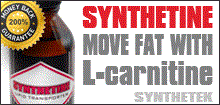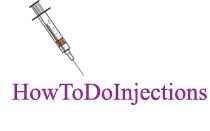- Joined
- Feb 4, 2003
- Messages
- 18
Fina users,, read this on prolactin
Here is an avenue that has not been explored in this thread: The potential relationship between trenbolone, thyrotropin-releasing hormone (TRH) and prolactin. TRH stimulates the synthesis and release of thyrotropin (thyroid stimulating hormone) from the pituitary. Thyrotropin in turn stimulates the release of the thyroid hormones. A negative feedback loop exists whereby low levels of T4 stimulate the release of TRH (1).
It has been established that in humans TRH is also capable of stimulating the release of prolactin (2). In hypothyroid patients there is often an elevation of TRH and prolactin due to diminished levels of T4. (3) Galactorrhea often presents as a symptom of hypothyroidism.
In sheep, administration of trenbolone acetate results in 45% decrease in thyroxine levels (4). This should exert a stimulatory effect on TRH. ( Interestingly, the same study shows that unlike in humans prolactin levels in the sheep remained unchanged. This is due to the fact that in sheep, unlike in humans, TRH and prolactin are secreted independently of each other (5).)
If it assumed that trenbolone acetate also lowers thyroxine levels in humans, the resulting rise in TRH would stimulate prolactin release, leading to galactorrhea and gynecomastia.
Due to the lack of human studies involving tren, we are all forced to speculate, and try to extrapolate from animal studies.
(1)Endocrinology 1999 Jan;140(1):43-9
Feedback regulation of thyrotropin-releasing hormone gene expression by thyroid hormone in the caudal raphe nuclei in rats.
Yang H, Yuan P, Wu V, Tache Y.
Digestive Diseases Research Center, West Los Angeles VA Medical Center, Department of Medicine and Brain Research Institute, UCLA, California 90073, USA. [email protected]
(2)Goodman and Gilman's The Pharmacological Basis of Therapeutics 8th ed. pp.1345-1346
(3) : Endocr J 1997 Feb;44(1):89-94
Incidence of hyperprolactinemia in patients with Hashimoto's thyroiditis.
Notsu K, Ito Y, Furuya H, Ohguni S, Kato Y.
Department of Medicine, Shimane Prefectural Central Hospital, Izumo, Japan.
(4)Res Vet Sci 1981 Jan;30(1):7-13
Growth hormone, insulin, prolactin and total thyroxine in the plasma of sheep implanted with the anabolic steroid trenbolone acetate alone or with oestradiol.
Donaldson IA, Hart IC, Heitzman RJ.
(5) Endocrinol 1988 Apr;117(1):115-22
Release of prolactin is independent of the secretion of thyrotrophin-releasing hormone into hypophysial portal blood of sheep.
Thomas GB, Cummins JT, Yao B, Gordon K, Clarke IJ.
Medical Research Centre, Prince Henry's Hospital, Melbourne, Australia.
--------------------------------------------------------------------------------
Yes, finally!!! you hit the nail right on the head.
Fina is a VERY POWERFUL anti-glucocorticoid, so what
exactly does it do to reduce endogeneous cortisone
levels?
There is only ONE mechanism:
A reduction in the TOTAL Free T4 and T3 levels within the
body.
T3 is HIGHLY catabolic to muscle, therefore by reducing it by(
take 45% as shown by Nandi as an example), you are
exerting a ridiculously high protein-sparing effect.
YES, thats right, Fina is not THAT anabolic IN VIVO, it is
far, and I do mean FAR more of an ANTI-CATABOLIC
AAS than anything else.
Ok, now lets back-track to the problem at hand.
TSH has been reduced by the trenbolone, which in
turns signals the thyroid to reduce endogeneously
produced levels of T3 and T4.
This reduction(As Nandi mentioned) causes a VERY
sharp drop in free T3 levels because of the reduction
in both the endogeneously produced T4 and T3.
(Remember that 80% of the free T3 is produced from
the metabolically inactive T4)
These dimished levels of T3,T4 cause Thyrotropin Releasing
Hormone(TRH) to become OVER-STIMULATED.
In essence, this is your bodies feed-back loop to reduced
thyroid hormones, due to a GLUCO-CORTICOID suppresive
effect. This is however NOT like hypothyroidic patients
who have a naturally defective(or damaged) thyroid.
When TRH becomes over-stimulated the net effect is
a VERY sharp increase in prolactin levels.
Critical here.....
I.E. YOU BEGIN TO LACTATE!!!!!
Now, herein lies the problem. Everybody is bio-chemically
different, therefore the TRH increase is EXTREMELY
broad-spectrum.
While someone will stimulate TRH say X% and ultimately
cause a rise in prolactin of say Y% with a daily
dosage of 50mg ED of Fina, another person will
cause a 2X% rise in TRH and 2Y+% rise in prolactin
which will invariably lead to gyno.
This is just genetics. Nothing can be done about this.
However, there are ways to combat prolactin-elevations:
This btw, HAS TO BE EXACT. If you over-dose you cause
a progestenic shift due to severely inhibited prolactin levels,
or if you under-dose you run the risk of getting prolactin
induced gyno.
As a note: PROGESTERONE does NOT, I repeat NOT come into
play with Fina at all. It only becomes into play when you're
trying to inhibit prolactin synthetically.
The only thing that can combat Fina-induced Gyno is:
1. 2.5mgs Bromocriptine broken down to 1.25mgs 2X/day
AM and PM.
Thats it.
No Vitex/Nolva/Clomid/Arimidex or whatever. They don't
work for Fina.
Those would work well with Deca. Winny would be the only help I would see with A-drol. That is one crazy substance
Here is an avenue that has not been explored in this thread: The potential relationship between trenbolone, thyrotropin-releasing hormone (TRH) and prolactin. TRH stimulates the synthesis and release of thyrotropin (thyroid stimulating hormone) from the pituitary. Thyrotropin in turn stimulates the release of the thyroid hormones. A negative feedback loop exists whereby low levels of T4 stimulate the release of TRH (1).
It has been established that in humans TRH is also capable of stimulating the release of prolactin (2). In hypothyroid patients there is often an elevation of TRH and prolactin due to diminished levels of T4. (3) Galactorrhea often presents as a symptom of hypothyroidism.
In sheep, administration of trenbolone acetate results in 45% decrease in thyroxine levels (4). This should exert a stimulatory effect on TRH. ( Interestingly, the same study shows that unlike in humans prolactin levels in the sheep remained unchanged. This is due to the fact that in sheep, unlike in humans, TRH and prolactin are secreted independently of each other (5).)
If it assumed that trenbolone acetate also lowers thyroxine levels in humans, the resulting rise in TRH would stimulate prolactin release, leading to galactorrhea and gynecomastia.
Due to the lack of human studies involving tren, we are all forced to speculate, and try to extrapolate from animal studies.
(1)Endocrinology 1999 Jan;140(1):43-9
Feedback regulation of thyrotropin-releasing hormone gene expression by thyroid hormone in the caudal raphe nuclei in rats.
Yang H, Yuan P, Wu V, Tache Y.
Digestive Diseases Research Center, West Los Angeles VA Medical Center, Department of Medicine and Brain Research Institute, UCLA, California 90073, USA. [email protected]
(2)Goodman and Gilman's The Pharmacological Basis of Therapeutics 8th ed. pp.1345-1346
(3) : Endocr J 1997 Feb;44(1):89-94
Incidence of hyperprolactinemia in patients with Hashimoto's thyroiditis.
Notsu K, Ito Y, Furuya H, Ohguni S, Kato Y.
Department of Medicine, Shimane Prefectural Central Hospital, Izumo, Japan.
(4)Res Vet Sci 1981 Jan;30(1):7-13
Growth hormone, insulin, prolactin and total thyroxine in the plasma of sheep implanted with the anabolic steroid trenbolone acetate alone or with oestradiol.
Donaldson IA, Hart IC, Heitzman RJ.
(5) Endocrinol 1988 Apr;117(1):115-22
Release of prolactin is independent of the secretion of thyrotrophin-releasing hormone into hypophysial portal blood of sheep.
Thomas GB, Cummins JT, Yao B, Gordon K, Clarke IJ.
Medical Research Centre, Prince Henry's Hospital, Melbourne, Australia.
--------------------------------------------------------------------------------
Yes, finally!!! you hit the nail right on the head.
Fina is a VERY POWERFUL anti-glucocorticoid, so what
exactly does it do to reduce endogeneous cortisone
levels?
There is only ONE mechanism:
A reduction in the TOTAL Free T4 and T3 levels within the
body.
T3 is HIGHLY catabolic to muscle, therefore by reducing it by(
take 45% as shown by Nandi as an example), you are
exerting a ridiculously high protein-sparing effect.
YES, thats right, Fina is not THAT anabolic IN VIVO, it is
far, and I do mean FAR more of an ANTI-CATABOLIC
AAS than anything else.
Ok, now lets back-track to the problem at hand.
TSH has been reduced by the trenbolone, which in
turns signals the thyroid to reduce endogeneously
produced levels of T3 and T4.
This reduction(As Nandi mentioned) causes a VERY
sharp drop in free T3 levels because of the reduction
in both the endogeneously produced T4 and T3.
(Remember that 80% of the free T3 is produced from
the metabolically inactive T4)
These dimished levels of T3,T4 cause Thyrotropin Releasing
Hormone(TRH) to become OVER-STIMULATED.
In essence, this is your bodies feed-back loop to reduced
thyroid hormones, due to a GLUCO-CORTICOID suppresive
effect. This is however NOT like hypothyroidic patients
who have a naturally defective(or damaged) thyroid.
When TRH becomes over-stimulated the net effect is
a VERY sharp increase in prolactin levels.
Critical here.....
I.E. YOU BEGIN TO LACTATE!!!!!
Now, herein lies the problem. Everybody is bio-chemically
different, therefore the TRH increase is EXTREMELY
broad-spectrum.
While someone will stimulate TRH say X% and ultimately
cause a rise in prolactin of say Y% with a daily
dosage of 50mg ED of Fina, another person will
cause a 2X% rise in TRH and 2Y+% rise in prolactin
which will invariably lead to gyno.
This is just genetics. Nothing can be done about this.
However, there are ways to combat prolactin-elevations:
This btw, HAS TO BE EXACT. If you over-dose you cause
a progestenic shift due to severely inhibited prolactin levels,
or if you under-dose you run the risk of getting prolactin
induced gyno.
As a note: PROGESTERONE does NOT, I repeat NOT come into
play with Fina at all. It only becomes into play when you're
trying to inhibit prolactin synthetically.
The only thing that can combat Fina-induced Gyno is:
1. 2.5mgs Bromocriptine broken down to 1.25mgs 2X/day
AM and PM.
Thats it.
No Vitex/Nolva/Clomid/Arimidex or whatever. They don't
work for Fina.
Those would work well with Deca. Winny would be the only help I would see with A-drol. That is one crazy substance





















































































